Growth and Bioactive Compound Content of Glehnia littoralis Fr. Schmidt ex Miquel Grown under Different CO2 Concentrations and Light Intensities
Abstract
1. Introduction
2. Results and Discussion
2.1. Growth Characteristics
2.2. Photosynthetic Rate and the SPAD Value
2.3. Total Sugar and Starch
2.4. Harvest Yield
2.5. Bioactive Compound
3. Materials and Methods
3.1. Plant Materials and Growth Condition
3.2. Growth Characteristics
3.3. Total Sugar and Starch
3.4. Bioactive Compounds
3.4.1. Chlorogenic Acid Concentration
3.4.2. Total Saponin Concentration
3.5. Statistical Analysis
4. Conclusions
Author Contributions
Funding
Acknowledgments
Conflicts of Interest
References
- Ministry of Food and Drug Safety (MFDS). Food & Drug Statistical Yearbook; Ministry of Food and Drug Safety: Cheongju, Korea, 2018. [Google Scholar]
- Ministry of Agriculture, Food and Rural Affairs (MAFRA). Production Performance of Industrial Crop; Ministry of Agriculture, Food and Rural Affairs: Sejong, Korea, 2018. [Google Scholar]
- Seo, Y.K.; Ryu, K.S. Study on the component of Glehniae Radix. Korean J. Pharmacogn. 1977, 7, 233–235. [Google Scholar]
- Yuan, Z.; Tezuka, Y.; Fan, W.; Kadota, S.; Li, X. Constituents of the underground parts of Glehnia littoralis. Chem. Pharm. Bull. 2002, 50, 73–77. [Google Scholar] [CrossRef] [PubMed]
- Kim, S.J.; Chin, Y.W.; Yoon, K.D.; Ryu, M.Y.; Lee, J.H.; Kim, J.W. Chemical constituents of Saposhnikovia divaricate. Korean J. Pharmacogn. 2008, 39, 357–364. [Google Scholar]
- Jia, Z.; Tang, M.; Wu, J. The determination of flavonoid contents in mulberry and their scavenging effects on superoxide radicals. Food Chem. 1999, 64, 555–559. [Google Scholar]
- Blois, M.S. Antioxidant determinations by the use of a stable free radical. Nature 1958, 181, 1199–1200. [Google Scholar] [CrossRef]
- McMurtrie, R.E.; Wang, Y.P. Mathematical models of the photosynthetic response of tree stands to rising CO2 concentration and temperatures. Plant Cell Environ. 1993, 16, 1–13. [Google Scholar] [CrossRef]
- Leadley, P.W.; Niklaus, P.A.; Stocker, R. A field study of the effects of elevated CO2 on plant biomass and community structure in a calcareous grassland. Oecologia 1999, 118, 39–49. [Google Scholar] [CrossRef]
- Ainsworth, E.A.; Rogers, A. The response of photosynthesis and stomatal conductance to rising [CO2]: Mechanisms and environmental interactions. Plant Cell Environ. 2007, 30, 258–270. [Google Scholar] [CrossRef]
- Xu, Z.Z.; Xhimizu, H.; Yagasaki, Y.; Ito, S.; Zheng, Y.R.; Zhou, G.S. Interactive effects of elevated CO2 drought, and warming on plants. J. Plant Growth Regul. 2013, 32, 692–707. [Google Scholar] [CrossRef]
- Prior, S.A.; Brett Runion, G.; Rogers, H.H.; Torbert, H.A.; Reeves, D.W. Elevated atmospheric CO2 effects on biomass production and soil carbon in conventional and conservation cropping systems. Glob. Chang. Biol. 2005, 4, 657–665. [Google Scholar] [CrossRef]
- Drennan, P.M.; Nobel, P.S. Responses of CAM species to increasing atmospheric CO2 concentration. Plant Cell Environ. 2000, 8, 767–781. [Google Scholar] [CrossRef]
- Poorter, H.; Navas, M. Plant growth and competition at elevated CO2: On winners, losers and functional groups. CO2 Biosph. 1993, 1, 77–97. [Google Scholar] [CrossRef]
- Dong, J.L.; Gruda, N.; Lam, S.K.; Li, X.; Duan, Z.Q. Effects of elevated CO2 on nutritional quality of vegetables: A review. Front Plant Sci. 2018, 9, 924. [Google Scholar] [CrossRef] [PubMed]
- Long, S.P.; Ainsworth, E.A.; Rogers, A.; Ort, D.R. Rising atmospheric carbon dioxide: Plants FACE the future. Annu. Rev. Biol. 2004, 55, 591–628. [Google Scholar] [CrossRef] [PubMed]
- Yu, J.H.; Shu, Y.J.; Lv, J.F.; Zhang, G.B. Influences of low temperature and poor light on photosynthetic characteristics in eggplant seedlings. Acta Bot. Boreali Occident. Sin. 2004, 24, 831–836. [Google Scholar]
- Chen, E.Y. Grain Yield and Protein Quality in Response to Shading after Anthesis and Nitrogen Regulation in Wheat. Ph.D. Thesis, Shandong Agricultural University, Tai’an, China, 2012. [Google Scholar]
- Qin, Y.; Zhang, H.; Dong, B.; Shi, C.; Li, Y.; Zhai, H.; Liu, M. Effects of elevated CO2 concentration on growth and water use efficiency of winter wheat under two soil water regimes. Agric. Water Manag. 2010, 97, 1742–1748. [Google Scholar]
- Shirke, P.A.; Pathere, U.V. Diuranal and seasonal changes in photosynthesis and photosystem 2 photochemical efficiency in Prosopis juliflora leaves subjected to natural environmental stress. Photosynyhetica 2003, 41, 83–89. [Google Scholar] [CrossRef]
- Farquhar, G.D.; Sharkey, T.D. Stomatal conductance and photosynthesis. Ann. Rev. 1982, 33, 317–345. [Google Scholar] [CrossRef]
- Rajapake, N.C.; Pollock, R.K.; McMahon, M.J. Interpretation of light quality measurements and plant response in spectral filter research. HortScience 1992, 27, 1208–1211. [Google Scholar] [CrossRef]
- Li, Q.; Kubota, C. Effects of supplemental light quality on growth and phytochemiclas of baby leaf lettuce. J. Envrion. Exp. Bot. 2009, 67, 59–64. [Google Scholar] [CrossRef]
- Long, S.P.; Humphries, S.; Falkowski, P.G. Photoinhibition of photosynthesis in nature. Annu. Rev. Plant Physiol. Plant Mol. Biol. 1994, 45, 633–662. [Google Scholar] [CrossRef]
- Steinger, T.; Roy, B.A.; Stanton, M.L. Evolution in stressful environments II: Adaptive value and costs of plasticity in response to low light in Sinapis arvensis. J. Evol. Biol. 2003, 16, 313–323. [Google Scholar] [CrossRef] [PubMed]
- Farrar, J.E.; Jones, D.L. The control of carbon acquisition by roots. New Philol. 2000, 147, 43–53. [Google Scholar] [CrossRef]
- Nager, K.A.; Schurr, U.; Walter, A. Dynamics of root growth stimulation in Nicotiana tabacum in increasing light intensity. Plant Cell Environ. 2006, 29, 1926–1945. [Google Scholar]
- Olschowski, S.; Geiger, E.M.; Herrmann, J.V.; Sander, G.; Grüneberg, H. Effects of red, blue, and white LED irradiation on root and shoot development of Calibrachoa cuttings in comparison to high pressure sodium lamps. Acta Hortic. 2016, 1134, 245–250. [Google Scholar] [CrossRef]
- Kitaya, Y.; Niu, G.; Kozai, T.; Ohashi, M. Photosynthetic photon flux, photoperiod, and CO2 concentration affect growth and morphology of lettuce plug seedling. HortScience 1998, 33, 58–62. [Google Scholar] [CrossRef]
- Zheng, J.; He, D.; Ji, F. Effects of light intensity and photoperiod on runner plant propagation of hydroponic strawberry transplants under LED lighting. J. Agric. Biol. Eng. 2019, 12, 26–31. [Google Scholar] [CrossRef]
- Xu, S.; Zhu, X.; Li, C.; Ye, Q. Effect of CO2 enrichment on photosynthesis and growth in Gerbera jamesonii. J. Sci. Hortic. 2014, 177, 77–84. [Google Scholar] [CrossRef]
- Song, K.S.; Jeon, K.S.; Park Choi, K.S.; Kim, C.H.; Park, Y.B.; Kim, J.J. Characteristics of photosynthesis and leaf growth of Peucedanum japonicum by leaf mold and shading level in forest farming. Korean J. Med. Crop Sci. 2015, 23, 43–48. [Google Scholar] [CrossRef]
- Croonenborghs, S.; Ceusters, J.; Londers, E.; De Proft, M.P. Effects of elevated CO2 on growth and morphological characteristics of ornamental bromeliads. Sci. Hortic. 2009, 2, 192–198. [Google Scholar] [CrossRef]
- Qian, T.; Dieleman, J.A.; Elings, A.; Marcelis, L. Leaf photosynthetic and morphological responses to elevated CO2 concentration and altered fruit number in the semi-closed greenhouse. Sci. Hortic. 2012, 145, 1–9. [Google Scholar] [CrossRef]
- Aranjuelo, I.; Cabrerizo, P.M.; Arrese-Igor, C.; Aparicio-Tejo, P.M. Pea plant responsiveness under elevated CO2 is conditioned by N source (N2 fixation versus NO3-fertilization). Envirion. Exp. Bot. 2013, 95, 34–40. [Google Scholar] [CrossRef]
- Tsukaya, H. Leaf shape: Genetic controls and environmental factors. Int. J. Dev. Biol. 2005, 49, 547–555. [Google Scholar] [CrossRef] [PubMed]
- Utasi, L.; Monostori, I.; Végh, B.; Pék, Z.; Éva, D. Effects of light intensity and spectral composition on the growth and metabolism of spinach (Spinacia oleracea L.). Acta Biol. Plant. Agriensis 2019, 7, 3–18. [Google Scholar]
- Feng, L.Y.; Raza, M.A.; Li, Z.C.; Chen, Y.K.; Khalid, M.H.B.; Du, J.B.; Liu, W.G.; Xu, X.L.; Song, C.; Yu, L.A.; et al. The influence of light intensity and leaf movement on photosynthesis characteristics and carbon balance of soybean. Front. Plant Sci. 2019, 9, 1952. [Google Scholar] [CrossRef]
- Lee, H.B.; Lee, U.H.; An, S.K.; Park, J.H.; Kim, K.S. Growth characteristics and flowering initiation of Phalaenopsis Queen Beer ‘Mantefon’ as affected by the daily light integral. Hortic. Environ. Biotechnol. 2019, 60, 637–645. [Google Scholar] [CrossRef]
- Pérez-López, U.; Sgherri, C.; Miranda-Apodaca, J.; Micaelli, F.; Lacuesta, M.; Mena-Petite, A.; Quartacci, M.F.; Muñoz-Rueda, A. Concentration of phenolic compounds is increased in lettuce grown under high light intensity and elevated CO2. Plant Physiol. Biochem 2018, 123, 233–241. [Google Scholar]
- Sgherri, C.; Scattino, C.; Pinzino, C.; Tonutti, P.; Ranieri, A.M. Ultarviolet-B radiation applied to detached peach fruit: A study of free radical generation by EPR spin trapping. Plant Physiol. Biochem. 2015, 96, 124–131. [Google Scholar] [CrossRef]
- Wang, S.Y.; Bunce, J.A.; Mass, J.L. Elevated carbon dioxide increased content of antioxidant. J. Agric. Food Chem. 2003, 51, 4315–4320. [Google Scholar] [CrossRef]
- Jaafar, H.Z.E.; Ibrahim, M.H.; Karimi, E. Phenolics and flavonoids compounds, phenylanine ammonia lyse and antioxidant activity responses to elevated CO2 in Labisia pumila (Myrisinaceae). Molecules 2012, 17, 6331–6347. [Google Scholar] [CrossRef]
- Becker, C.; Kläring, H.P. CO2 enrichment can produce high red leaf lettuce yield while increasing most flavonoid glycoside and some caffeic acid derivative concentration. Food Chem. 2016, 199, 736–745. [Google Scholar] [CrossRef] [PubMed]
- Kawasaki, S.I.; Toniaga, J.; Yabuta, S.; Wantanabe, K.; Jaiphong, T.; Ueno, M.; Kawamitsu, Y. Responses of growth, photosynthesis, and associated component to hypoxia at different light intensities in red leaf lettuce. Sci. Hortic. 2015, 193, 330–336. [Google Scholar] [CrossRef]
- Hoagland, D.R.; Arnon, D.I. The Water-Culture Method for Growing Plants without Plant, 3rd ed.; University of California, College of Agriculture, Agricultural Experiment Station: Oakland, CA, USA, 1950. [Google Scholar]
- Makker, H.P.S.; Becker, K. Nutrients and antiquality factors in different morphological parts of the Moringa oleifera tree. J. Agric. Sci. 1997, 128, 311–322. [Google Scholar] [CrossRef]

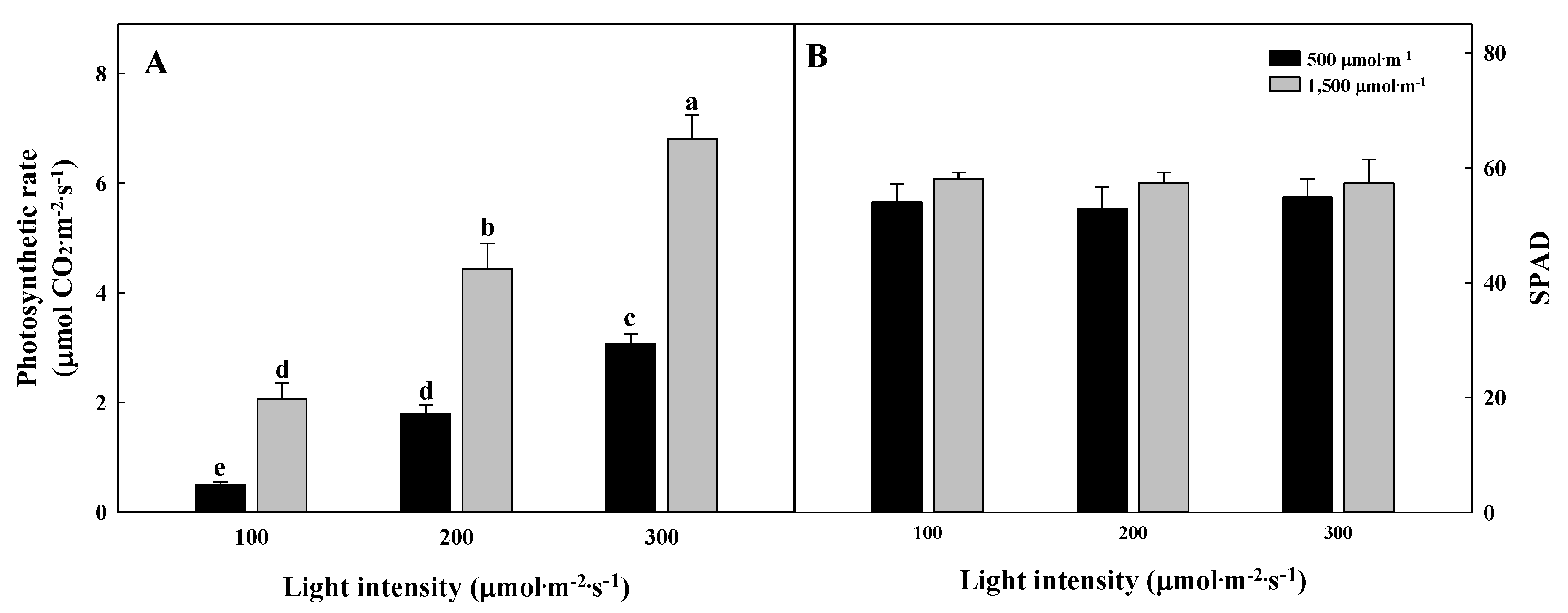
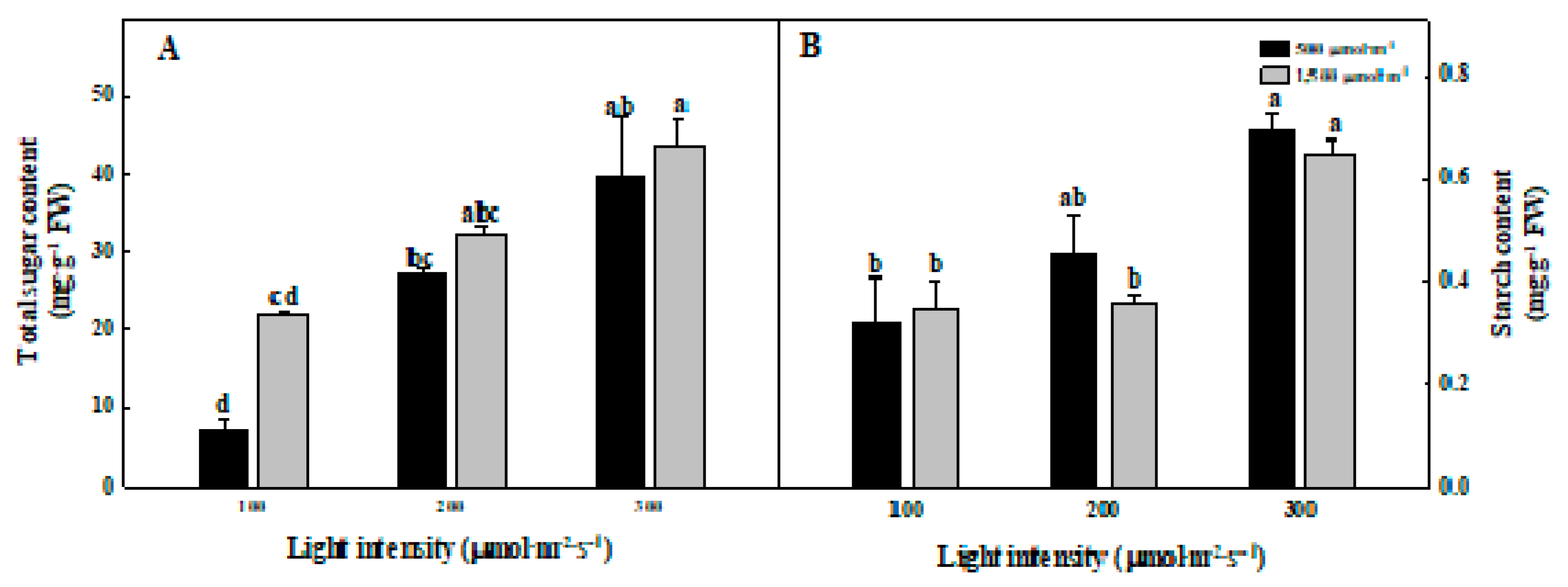
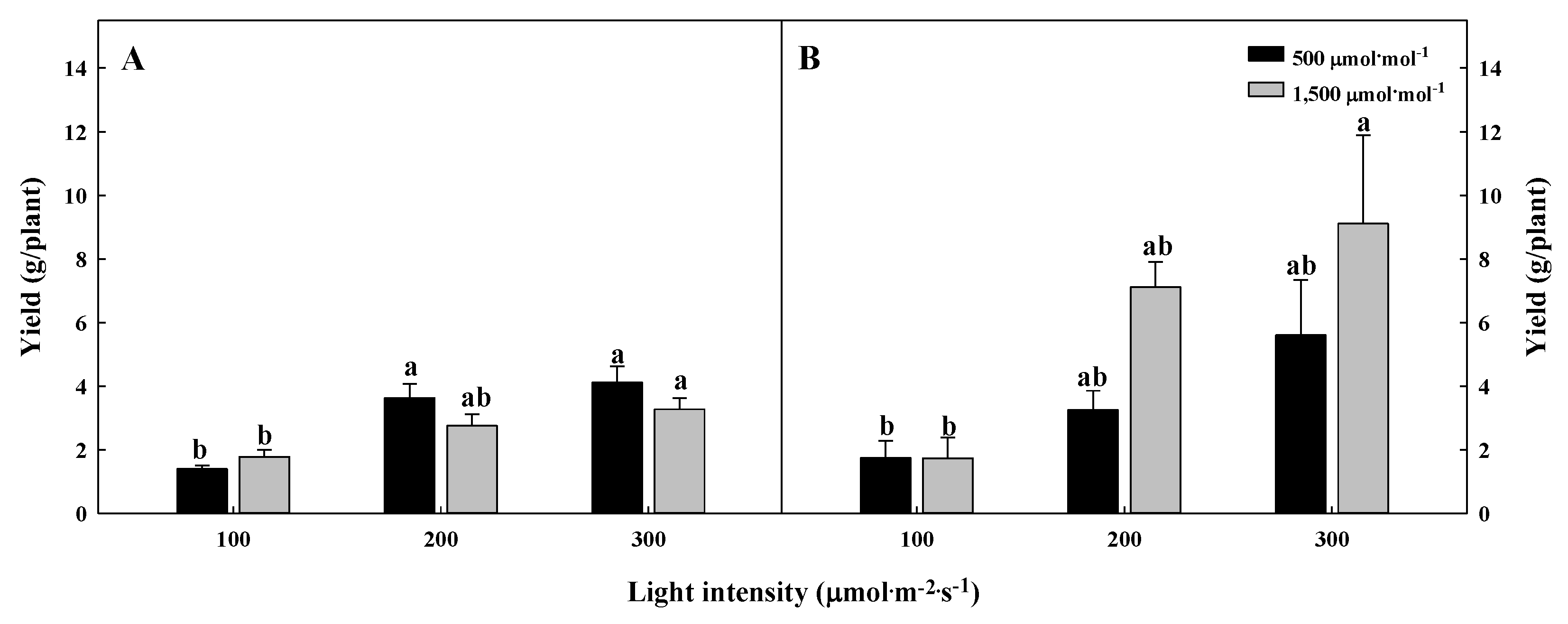
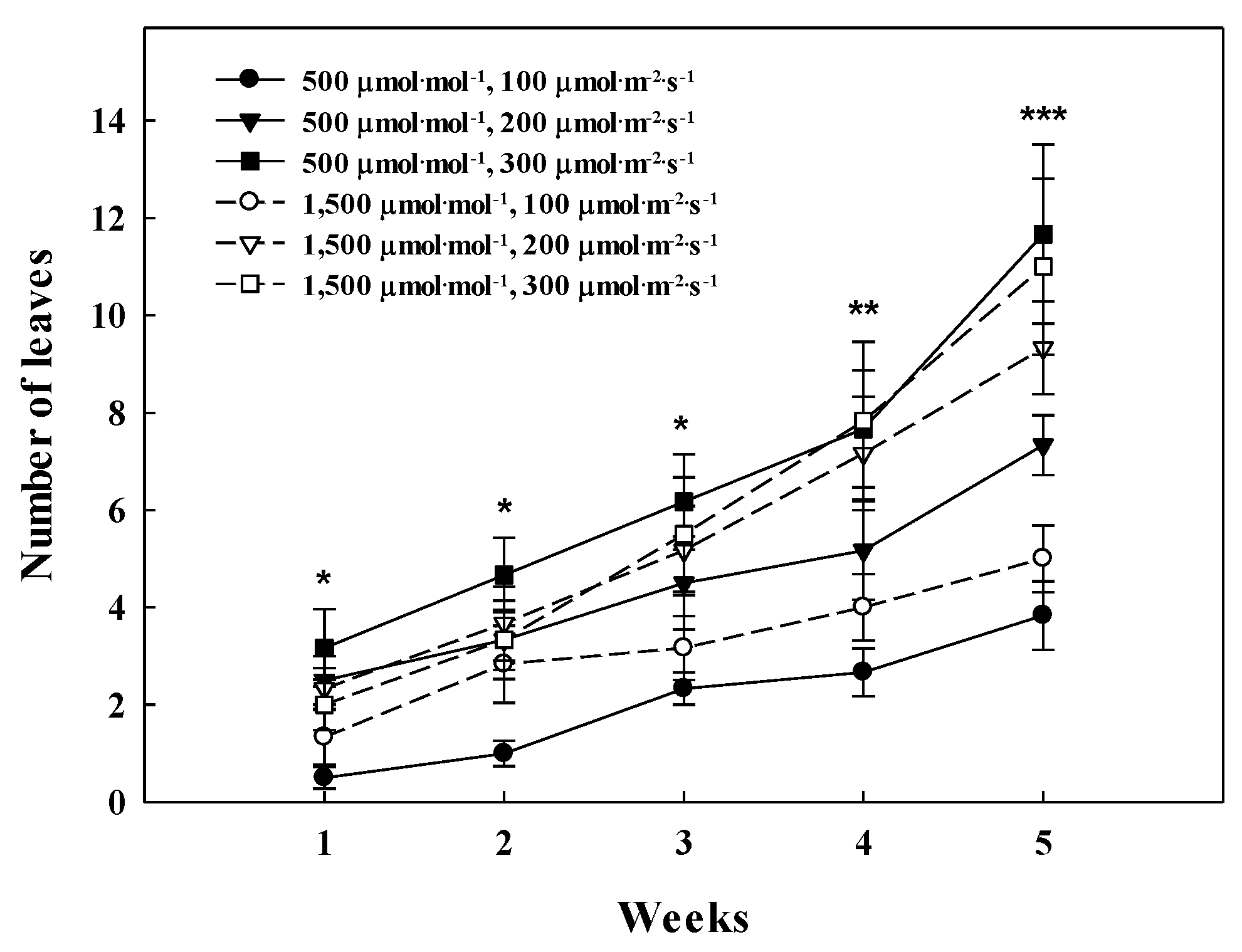
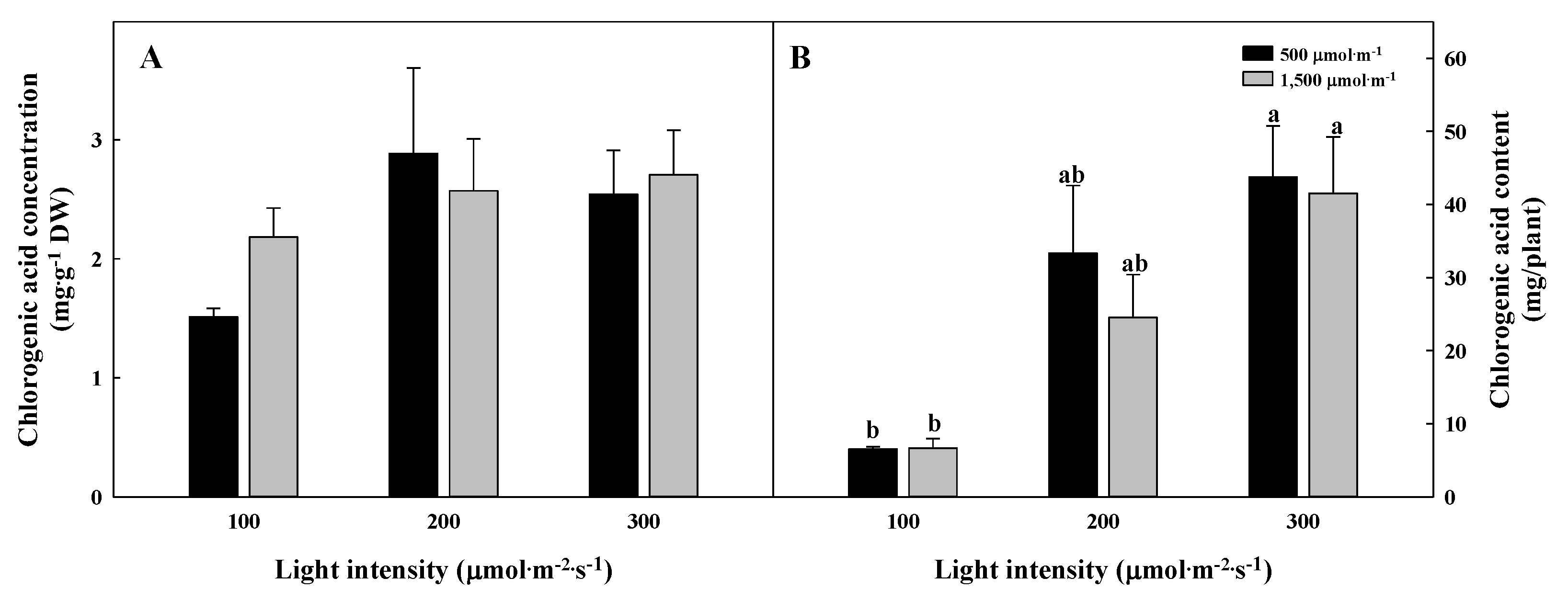
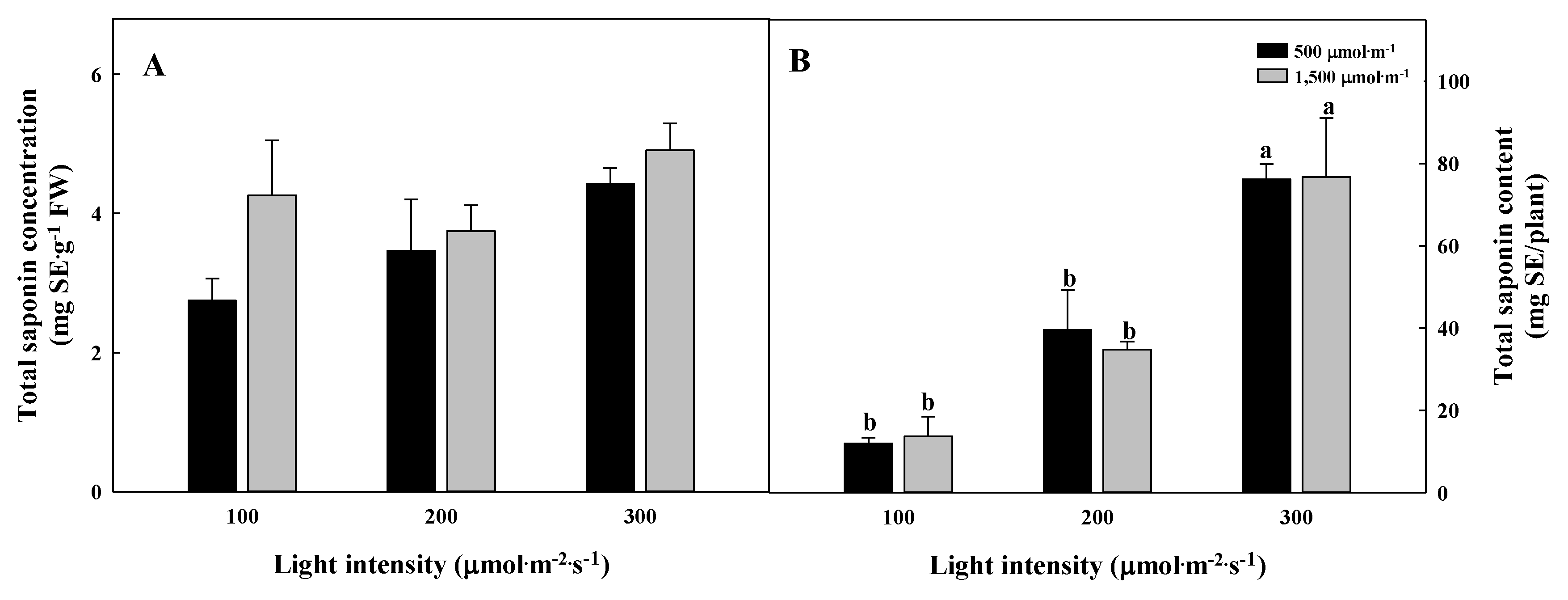

| CO2 Concentration (µmol∙mol−1) (A) | Light Intensity (µmol∙m−2∙s−1) (B) | Petiole Length (cm) | Leaf Area (cm2/plant) | Crown Diameter (mm) | No. of Leaves | Fresh Weight (g/plant) | Dry Weight (g/plant) |
|---|---|---|---|---|---|---|---|
| 500 | 100 | 8.8 ± 0.9 a z | 82.65 ± 13.1 bc | 8.0 ± 0.6 bc | 8.0 ± 0.6 bc | 5.93 ± 1.1 bc | 1.28 ± 0.2 bc |
| 200 | 7.0 ± 0.7 ab | 112.23 ± 19.7 ab | 13.5 ± 2.1 ab | 12.2 ± 2.1 ab | 8.19 ± 1.7 ab | 1.61 ± 0.4 ab | |
| 300 | 5.3 ± 0.4 b | 142.78 ± 13.4 a | 13.8 ± 1.7 a | 14.2 ± 3.0 ab | 10.85 ± 0.7 a | 2.17 ± 0.2 a | |
| 1500 | 100 | 6.6 ± 0.7 ab | 46.60 ± 9.5 c | 7.6 ± 0.5 c | 6.8 ± 1.4 c | 3.12 ± 0.6 c | 0.58 ± 0.1 c |
| 200 | 5.0 ± 0.3 b | 104.33 ± 15.1 ab | 14.7 ± 1.4 a | 16.5 ± 1.2 a | 7.55 ± 1.2 ab | 1.53 ± 0.2 ab | |
| 300 | 5.2 ± 0.2 b | 107.04 ± 17.7 ab | 13.8 ± 0.6 a | 12.7 ± 1.4 ab | 9.15 ± 1.1 ab | 2.01 ± 0.2 ab | |
| Significance y | A | ** | * | NS | NS | NS | NS |
| B | *** | ** | *** | *** | *** | *** | |
| A × B | NS | NS | NS | NS | NS | NS |
| CO2 Concentration (µmol∙mol−1) (A) | Light Intensity (µmol∙m−2∙s−1) (B) | Root Length (cm) | Root Diameter (mm) | Fresh Weight (g/plant) | Dry Weight (g/plant) |
|---|---|---|---|---|---|
| 500 | 100 | 10.7 ± 0.4 b z | 9.6 ± 0.5 ab | 4.53 ± 0.2 cd | 1.20 ± 0.1 c |
| 200 | 29.9 ± 1.5 a | 11.0 ± 0.3 a | 11.60 ± 2.4 ab | 1.68 ± 0.4 bc | |
| 300 | 26.3 ± 2.2 a | 12.0 ± 0.7 a | 16.60 ± 0.7 a | 2.71 ± 0.1 a | |
| 1500 | 100 | 11.3 ± 0.5 b | 6.5 ± 0.8 b | 3.81 ± 0.7 d | 0.80 ± 0.2 c |
| 200 | 25.5 ± 1.6 a | 10.4 ± 1.3 a | 10.12 ± 1.3 bc | 1.51 ± 0.4 bc | |
| 300 | 31.7 ± 1.5 a | 12.3 ± 0.4 a | 14.83 ± 1.8 ab | 2.20 ± 0.2 ab | |
| Significance y | A | NS | NS | NS | NS |
| B | *** | *** | *** | *** | |
| A × B | ** | NS | NS | NS |
Publisher’s Note: MDPI stays neutral with regard to jurisdictional claims in published maps and institutional affiliations. |
© 2020 by the authors. Licensee MDPI, Basel, Switzerland. This article is an open access article distributed under the terms and conditions of the Creative Commons Attribution (CC BY) license (http://creativecommons.org/licenses/by/4.0/).
Share and Cite
Lee, H.R.; Kim, H.M.; Jeong, H.W.; Oh, M.M.; Hwang, S.J. Growth and Bioactive Compound Content of Glehnia littoralis Fr. Schmidt ex Miquel Grown under Different CO2 Concentrations and Light Intensities. Plants 2020, 9, 1581. https://doi.org/10.3390/plants9111581
Lee HR, Kim HM, Jeong HW, Oh MM, Hwang SJ. Growth and Bioactive Compound Content of Glehnia littoralis Fr. Schmidt ex Miquel Grown under Different CO2 Concentrations and Light Intensities. Plants. 2020; 9(11):1581. https://doi.org/10.3390/plants9111581
Chicago/Turabian StyleLee, Hye Ri, Hyeon Min Kim, Hyeon Woo Jeong, Myung Min Oh, and Seung Jae Hwang. 2020. "Growth and Bioactive Compound Content of Glehnia littoralis Fr. Schmidt ex Miquel Grown under Different CO2 Concentrations and Light Intensities" Plants 9, no. 11: 1581. https://doi.org/10.3390/plants9111581
APA StyleLee, H. R., Kim, H. M., Jeong, H. W., Oh, M. M., & Hwang, S. J. (2020). Growth and Bioactive Compound Content of Glehnia littoralis Fr. Schmidt ex Miquel Grown under Different CO2 Concentrations and Light Intensities. Plants, 9(11), 1581. https://doi.org/10.3390/plants9111581





